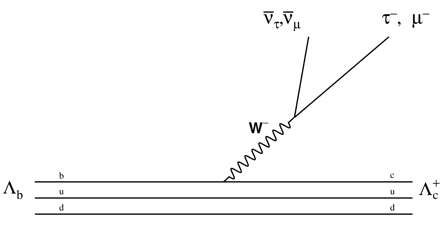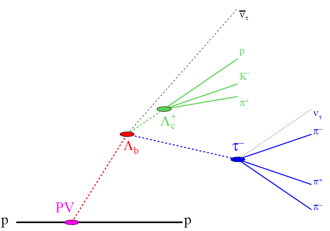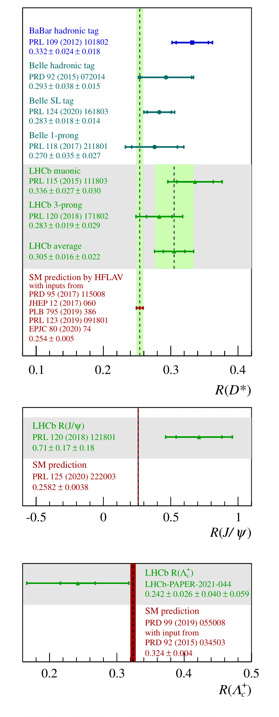Today at the 30th International Symposium on Lepton Photon Interactions at High Energies, organized by the University of Manchester, the LHCb Collaboration presented new tests of lepton universality, one of the basic principles of the Standard Model (SM) of particle physics. This principle states that the SM treats the three charged leptons (electrons, muons and taus) identically, except for differences due to their different masses. Recent LHCb results studied lepton universality between muons and electrons. The new measurements report the first observation of the semileptonic b-baryon decay Λb0→ Λc+τ–ντ and compares it to the corresponding decay in which the τ lepton is replaced by the muon. The ratio of the two decay rates, R(Λc+), is in good agreement with the SM prediction. An upper limit of R(Λc+) constrains some New Physics (NP) models.
The study of the Λb0→ Λc+τ–ντ decay is particularly challenging. The Λb0 baryon decays at a distance of about a cm from the proton-proton collision point (PV). The Λc+ baryon is identified through its decay into a proton and a K– π+ meson pair. The τ leptons are formed from π–π+π– meson combinations. The decay of the τ lepton produces these three pions along with a neutrino (ντ) and sometimes an additional neutral pion, neither of which are reconstructed in this analysis. The 3-pion decay, only exploited by LHCb up to now, has two advantages: the precise measurement of τ lepton decay point which enables a very strong background rejection, and the exploitation of the dynamics of the 3 pion system which helps to distinguish tau decays from backgrounds in which the 3 pions are coming from charmed meson decays.
A selection algorithm based on a boosted decision tree is used to separate about 350 Λb0→ Λc+τ–ντ events from the background. The statistical significance of the signal is about six standard deviations, making this the first observation of this decay. The rate or “branching fraction”of this decay (B(Λb0→ Λc+τ–ντ)) was then compared with the corresponding one where the τ lepton is replaced by a muon, measured by the DELPHI experiment at CERN.
In this way the value of lepton universality variable R(Λc+) was calculated to be
R(Λc+)=B(Λb0→ Λc+τ–ντ)/B(Λb0→ Λc+μ–ντ) = 0.242±0.026±0.040±0.059
This value is in good agreement with the SM prediction of 0.324±0.004.
The image to the left shows a compilation of lepton universality tests with τ leptons. The upper part shows the results of BaBar, Belle and LHCb collaborations for R(D*), the ratio of branching fractions between B0→D*-τ+ντ and B0→D*-μ+νμ (see this news article from 6 June 2017). The middle part shows the result of LHCb measurement of the R(J/ψ), the ratio of branching fractions between Bc+→J/ψτ+ντ and Bc+→J/ψμ+νμ using τ+→ μ+νμ ντ decays, see the 13 September 2017 news. Finally, the new result presented today is shown in the lowest part of the image. It is interesting to notice that different experiments operating either at pp (LHCb) or e+e– (BaBar, Belle) colliders, using very different experimental techniques, measure values systematically above the SM prediction for R(D*) and R(J/ψ), even if each measurement is statistically not very significant. Today’s result is in good agreement with the SM prediction and its central value is located below the SM prediction. It is, however, interesting to note that some NP models predict R(Λc+) significanly higher or significantly below its SM values even after taking into account the present R(D*) and R(J/ψ) central values. Today’s result will trigger intensive discussions among the theoretical physics community.
LHCb physicists have also studied lepton universality in rare beauty particle decays into muons and electrons. See the latest results in the 19 October 2021 news.
To find out more check out presentations [1] and [2] at the symposium and the LHCb paper. Read more in the CERN Courier article.



